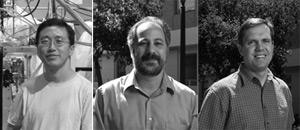
Handy Links
SLAC News Center
SLAC Today
- Subscribe
- Archives: Feb 2006-May 20, 2011
- Archives: May 23, 2011 and later
- Submit Feedback or Story Ideas
- About SLAC Today
SLAC News
Lab News
- Interactions
- Lightsources.org
- ILC NewsLine
- Int'l Science Grid This Week
- Fermilab Today
- Berkeley Lab News
- @brookhaven TODAY
- DOE Pulse
- CERN Courier
- DESY inForm
- US / LHC
SLAC Links
- Emergency
- Safety
- Policy Repository
- Site Entry Form

- Site Maps
- M & O Review
- Computing Status & Calendar
- SLAC Colloquium
- SLACspeak
- SLACspace
- SLAC Logo
- Café Menu
- Flea Market
- Web E-mail
- Marguerite Shuttle
- Discount Commuter Passes
-
Award Reporting Form
- SPIRES
- SciDoc
- Activity Groups
- Library
Stanford
Around the Bay
Three Research Grants and a New Branchline for SIMES and SSRL

The Department of Energy has awarded $9.4 million in Single Individual and Small Group Research grants to scientists at the Stanford Synchrotron Radiation Lightsource at SLAC National Accelerator Laboratory and the Stanford Institute for Materials and Energy Science, a joint Stanford/SLAC institute. The awards will support development of basic research, including the construction of a new experimental branchline at SSRL.
Of the total, $4.8 million was awarded to physicist Donghui Lu and will be used for upgrades at SSRL. The other $4.6 million will help fund SIMES research projects led by physicist Tom Devereaux and materials scientist Nick Melosh.
"The funding will allow SIMES to expand into exciting new directions," SIMES Director Zhi-Xun Shen said. "It will help SIMES researchers conduct experiments at SSRL that are not currently possible, contribute to LCLS materials science program in an innovative way and develop a leading diamondoids program that will have rich scientific content and significant potential for new energy applications."
At SSRL, the funding will support the construction of a new branchline at Beamline 5. The new experimental branchline will allow researchers to study complex and nano-scale phenomena in solids and probe previously indeterminable characteristics of matter. Work on the project will start almost immediately, and will take approximately three years to complete.
"This is an important new addition that will allow our beamline group to push further to advance SSRL capabilities," said SSRL Director Piero Pianetta.
For SLAC physicist Tom Devereaux, who will receive $2.1 million in SISGR funding, the additional resources will allow the development of new materials science investigations at the Linac Coherent Light Source. Devereaux's research group will focus on using the soft X-ray capabilities of the LCLS to conduct X-ray scattering studies of novel materials. The work will also help researchers to learn how the LCLS—the world's first hard X-ray laser beam—interacts with matter. The funds will cover the costs of building scientific instruments as well as the salaries of students and employees involved in the project.
"This funding allows us to be at the forefront of X-ray investigations of matter," Devereaux said. "These kinds of experiments cannot be done anywhere else, and will help drive future materials science studies at LCLS."
The funding will also spur research on diamondoids—a unique nanomaterial found in petroleum that has potential applications ranging from electronics to medicine. SIMES researcher Nick Melosh will receive $2.5 million to conduct studies focusing on the conductive properties of diamondoids as well as potential applications in flat panel displays and solar panels.
"Diamondoids have been really exciting in terms of new discoveries. It's a really new material, and if you don't have funding for basic research, then it's hard to make advances," Melosh said. "The funding will allow us to turn diamondoids toward energy applications as well."
—Nicholas Bock
SLAC Today, July 27, 2009